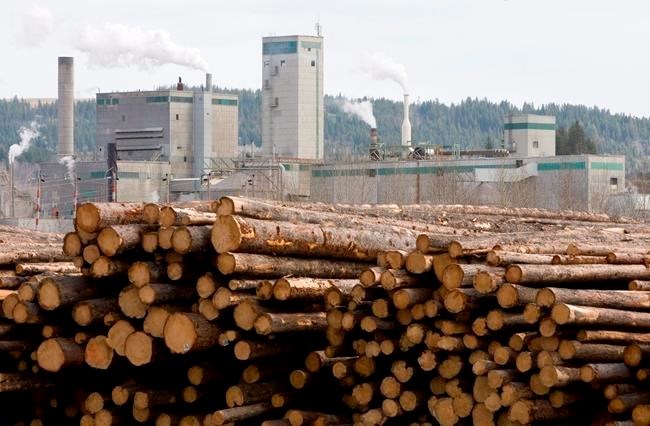Canfor’s plan to permanently shut down the pulp line at Prince George Pulp and Paper by March and potentially put as many as 300 mill workers out of work is not the only grim reality facing the north central B.C. wood industry.
The lack of economical fibre in the region and low lumber prices that have forced curtailments and reduced the availability of residual wood chips from sawmills means at least one more pulp mill in the region will likely be targeted for closure, according to forest industry expert Ben Parfitt.
“I think people don’t really appreciate just how significant the reductions ahead are going to be and what that is going to translate into in the Interior,” said Parfitt, resource policy analyst for the Canadian Centre for Policy Alternatives.
“Unfortunately there’s every reason to believe that we’re going to see further mill closures and I wouldn’t be at all surprised to see another pulp mill in the Interior of the province go down, nor would I be surprised to see a number of other sawmills close as well.”
The most likely pulp candidates for closure are Canfor’s Taylor mill, which was shut down in November and won’t be restarted until spring, as well as one of West Fraser’s two mills in Quesnel, Cariboo Pulp and Paper or Quesnel River Pulp.
In addition to the pending PG Pulp closure, Canfor has announced it will close its pellet mill and lumber mill in Chetwynd and its lumber mill in Houston. That comes after the March 2022 closure of the Pacific Bioenergy Pinnacle pellet mill in Prince George after 22 years of operation.
Parfitt says the lack of fibre stems from the B.C. government encouraging harvesting of beetle-killed pine and spruce forests after infestations began in 2009, which depleted supplies and created an overabundance of mill capacity that has deepened the crisis.
“We need to be thinking very carefully in British Columbia about how we start to diversify the industry and in my view we have made mistakes in the past by putting so many eggs into one basket, in this case into the pellet basket,” said Parfitt.
The pellet wood industry that took root in Quesnel and Williams Lake around 2008 as an efficient home heating source has expanded to 13 pellet plants in B.C. and that’s created a new sector that is competing with mills for pulp logs and increasing pressure on the forest industry.
Parfitt said the province would have been better off to give secondary value-added forest companies access to timber supplies the pellet industry is now using. Most of the pellets made in B.C. are shipped overseas by Drax Group, a British-based energy company that sells pellets in Europe and Asia for generating electricity.
“Those pellet plants are consuming an immense amount of wood, about five million cubic metres equivalent per year, which in my view has effectively taken wood away from companies that could have added more value and produced more jobs with that wood,” said Parfitt.
“Pellets, in my view, are an extremely poor choice because huge amounts of wood are needed to sustain jobs in the pellet industry, while producing very few jobs.”
He said increased competition for wood from the pellet industry resulted in pulp mills having to turn whole pulp logs into chips, which has driven up production costs dramatically.
Last week, B.C. Forest Minister Bruce Ralston announced a new $25 million Forest Landscape Planning program to better protect old-growth forests and encourage innovation in the industry. The province will expand old-growth deferrals to 2.1 million hectares, up from 1.7 million ha last spring. The new funding will create eight regional forest landscape planning tables that will include 50 B.C. First Nations which will shape decisions on where harvesting and road building will occur.
The government is shaping forestry legislation to include more Indigenous engagement in resource management in line with the principles outlined in the United Nations Declaration on the Rights of Indigenous Peoples passed in 2019.
The NDP is also doubling its BC Manufacturing Jobs Fund to $180 million to support the value-added forestry sector and create products such as mass timber structural lumber using smaller-dimension trees.
“If the provincial government is serious about moving up the value chain in the forest industry it’s got an awful lot of work to do,” said Parfitt. “Even with the recent announcement to increase the value-added fund to $180 million is really not sufficient given the kinds of investments that would be required to reposition the industry.”
As an example of the unsustainability of current harvesting practices, Parfitt says some logging trucks are being loaded in the far reaches of the Nass timber supply area north of Terrace, driven 500 kilometres to be off-loaded at Houston, where another truck drives the same load another 300 km to Prince George.
When the lumber market reached historic highs in 2021, companies like Canfor could afford to go further in search of wood and recorded record profits despite lower logging rates. But now with prices below the break-even point of $500 US per thousand board feet and available fibre supplies expected to continue to decline than that’s prompted the latest round of mill closures.
“We are running out of forest,” Parfitt said. “Too much has been cut too quickly and we’re facing that inevitable day of reckoning and if we want to start to move away from the crisis we’re in it’s by getting the industry to start to do very different things from what it is currently doing, and that will take time and investment.”
Parfitt lives in Victoria and be a virtual guest speaker at the Future of Forestry forum next Tuesday at 6:30 p.m. at UNBC’s Canfor Theatre.




